Dear creative friends,
Welcome to Issue No. 55 of the StudioWorks Journal! It brings me immense joy to have you here, and I am thrilled to embark on this artistic journey together. In this edition, we will delve into the enchanting world of soft pastels and uncover the boundless possibilities that this medium offers.
This month, we will explore the captivating language of color, emotion, and mark making, as we seek to deepen our understanding of artistic expression. Soft pastels have a unique ability to capture the subtleties and nuances of our innermost thoughts and feelings. They allow us to paint with a softness and sensibility that enables our art to breathe and come alive.
Let us embrace the gentle nature of soft pastels and unlock the expressive potential that lies within each stroke. I can't wait to witness the beauty that will unfold as we embrace the soft pastel medium. Let’s begin…
xo,

So you may be wondering, where do I start? To that, I say, wherever feels right to you. Each month we will have a theme, a creative affirmation, a power word, a color palette, sketchbook exercises, art projects, articles, recommended reading, and access to wonderful inspiration and resources. I want you to think of this as a delicious new magazine, you know the ones you occasionally splurge on, with soft, velvety pages, beautiful images, and inspiring content!
Each issue will invite you to explore your creative practice in whichever way works for you. Experience each issue at your own pace. Take what resonates with you and put the rest aside for another time.
Grab a cup of something lovely and dive in.
Everything has an origin story, but not all of them are noteworthy. In the case of soft pastels, they were bound for glory from their inception. Created in Italy during the sixteenth century, they were used extensively by Renaissance greats such as Leonardo da Vinci and Michelangelo. In the hands of such masters, it’s no wonder that the medium made an enduring impression.
Pastels have not always garnered the respect they deserve despite their auspicious beginnings. People sometimes view them as little more than crayons, an amateur’s implement, only relevant for serious artists as a simple drawing tool. Still, regardless of ebbs and flows in popular opinion, pastels have always retained their place in the hearts of artists, as their illustrious tale reveals.
Leonardo da Vinci not only used pastels extensively, but he also deserves some credit for their invention. In 1499 while employed as the artist in residence for the Duke of Milan, he encountered the artist Jean Pérreal, the Court Painter for King Louis XII of France. Though the circumstances of their meeting were less than savory, occasioned by the invasion of Italy by France, this didn’t stop Leonardo from being impressed by the chalk Jean used to capture scenes in the field. He made a note to himself to ask how to make and use them.
Being the visionary that he was, Leonardo didn’t settle for the initial recipe with its mess and smudging, inherent traits of chalk. Instead, he crafted his own formula, adding a little wax to the pigment as a binder, a process that modern manufacture mirrors. This innovation adds yet another jewel to the crown of this storied artist.
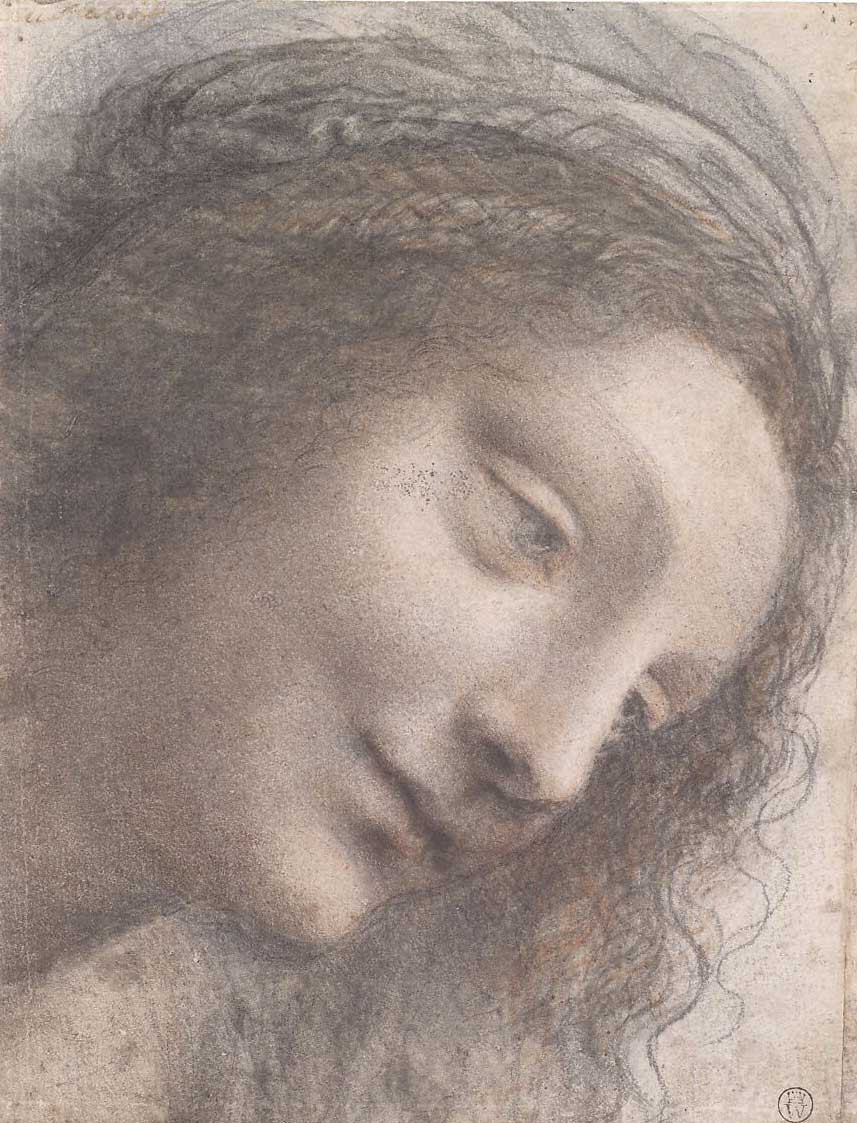
The Head of the Virgin in Three-Quarter View Facing Right
Leonardo da Vinci , 1510–13. Pastel on paper
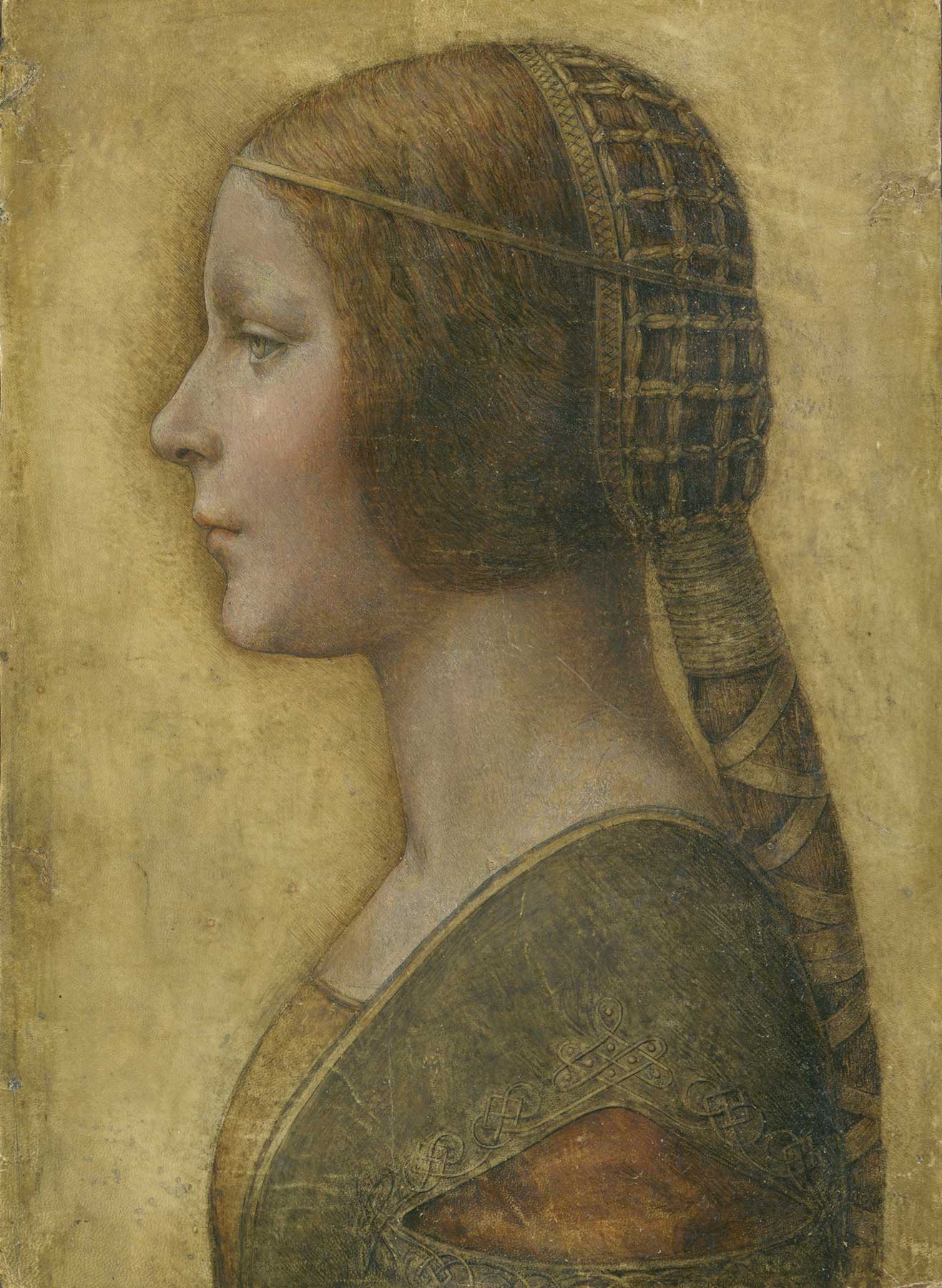
La Bella Principessa, Leonardo da Vinci,
1495-6. Pastel on panel
Initially available in only three colors, red, black, and white, the scope and detail that early pastelists accomplished were impressive. Underscoring the significance of this feat is that, in contrast, modern artists have more than 1600 hues and shades at their disposal!
Though the Renaissance was the launching point of pastels, it wasn’t until a century later that they gained broader traction. A surge in the use of pastels for portraiture injected the medium with a hefty dose of respectability.
Among the earliest artists to create finished pastels was Italian artist Benedetto Luti, but what concretized the value of the medium was when Joseph Vivien was received into the French Académie Royale in 1701 as a painter in pastel. Soon thereafter, pastels were launched into international renown through the works of Venetian artist Rosalba Carriera. Her portraits were sought after by royalty, and her skill earned her recognition as the first pastel artist.
The phenomenal works by Swiss-French artist Jean-Etienne Liotard broadened the scope of pastels beyond portraits. The realism of pieces such as The Chocolate Girl is remarkable even by contemporary standards.
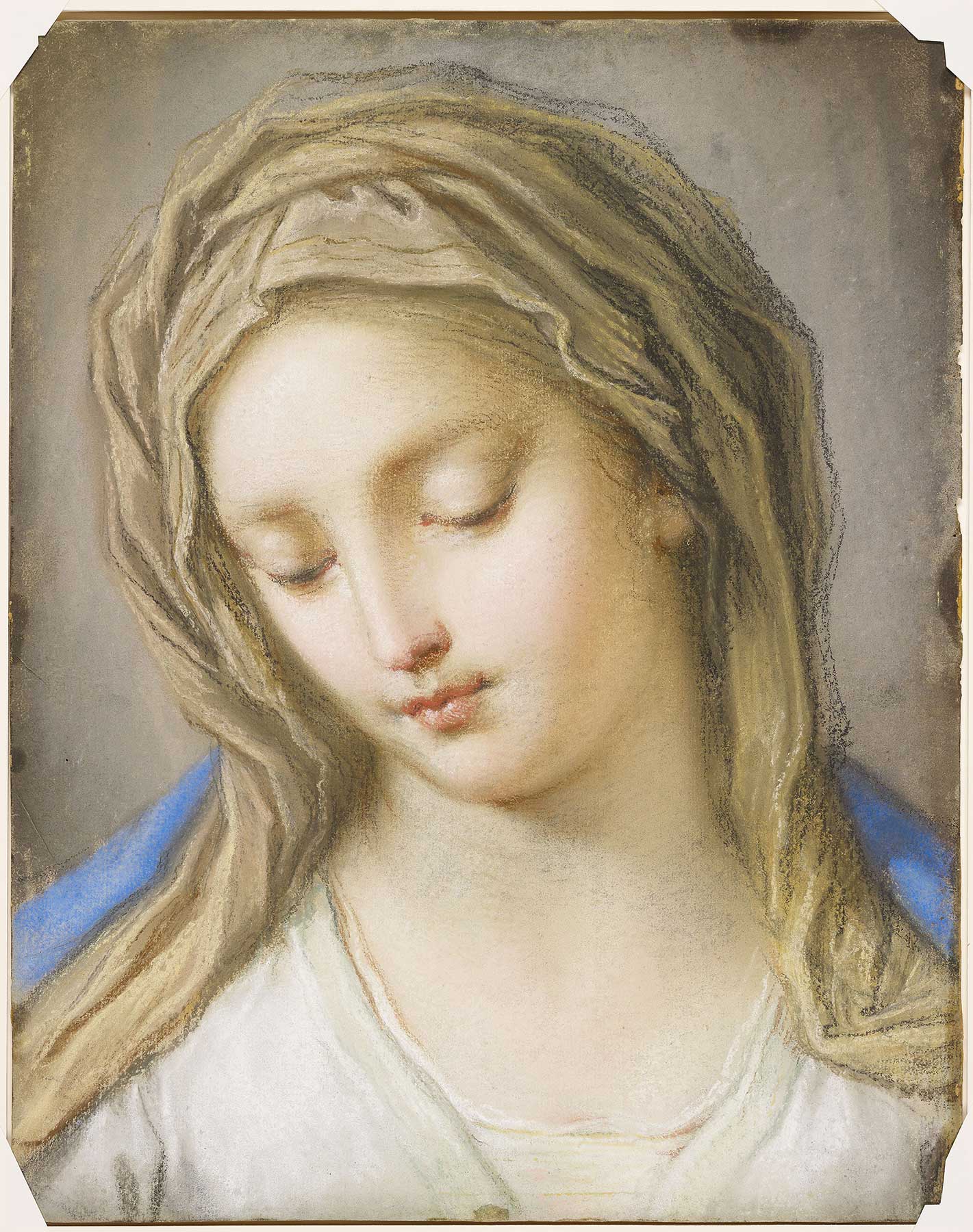
Benedetto Luti, 1666-1724, Head of the Virgin ,1714
Pastel on paper
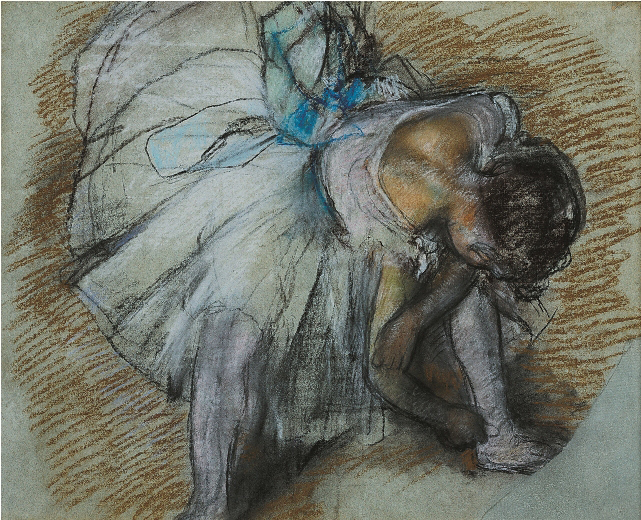
Edgar Degas Dancer Adjusting Her Shoe, 1885.
Pastel on paper
Though pastel briefly fell out of favor after the French Revolution because of its association with the old regime, it began its return to popularity by the middle of the 19th century. This revival was spearheaded by French artists such as Eugène Delacroix, Jean-François Millet, and Édouard Manet, who all regularly used pastels.
However, the true reinvention of pastels is due to the innovations of Edgar Degas. His extensive use of the medium in new and vigorous ways made him one of the most prolific and well-known pastelists. He even inspired a line of pastels by Gustave Sennelier that would go on to be used by Cézanne, Gauguin, Monet, and Modigliani.
Also worthy of honorable mention is the protégé of Degas, American artist Mary Cassatt. She crafted masterful pieces in pastel and brought interest in the medium to America while simultaneously introducing the works of the Impressionists to fellow artists in the States.
Pastels have their origin in the needs of a moment. A fastidious inventor needed something a little easier to control and a bit less messy. This stroke of genius improved upon standard chalks and gave a lasting medium with excellent portability and versatility.
The newly minted medium cut its teeth in sketches and portraiture but became a favorite amongst innovators of all kinds, showing its utility across diverse styles from realism to expressionism. Though briefly shunned by the artist community, the hero of our tale made an impressive rebound and now boasts pastel societies across the globe and unflinching stature as one of the major mediums in fine art.
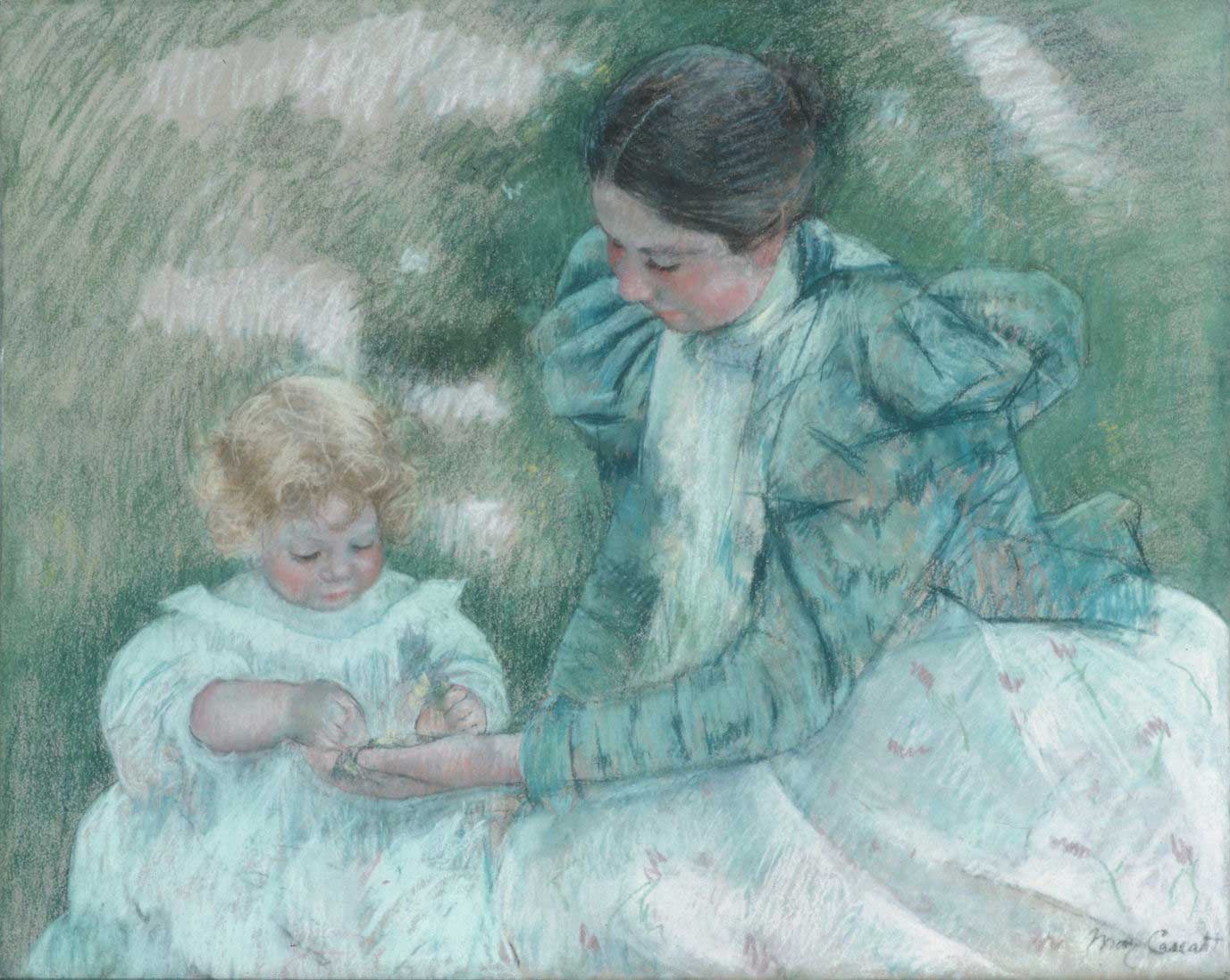
Mary Cassatt (1844–1926), Mother Playing with Child (c 1897), Pastel on wove paper, mounted on cardboard
Pastel is both a noun and an adjective referring to the medium itself or gentle shades of a color. The latter definition can be misleading in terms of how the medium is understood. In truth, pastels can bestow the lightest touch but also the deepest saturation. They are not to be relegated to the timid colors of Easter eggs; they are much more than that.
If we pay closer attention, listening in on the utterings of pastel, we will hear both whisper and roar. This medium garners sweetness through its play of contrasts. Let’s tune into its dulcet tones.
Pastel can come to us in many formats stick, square, pebble, or pan, but essentially it is pure pigment, an inert white filler, and a binder such as gum or wax. The absence of liquid makes pastels the most permanent of colors, free from oxidization, that withering process often synonymous with aging.
In addition to its permanence, when archivally grounded, pastel is particularly prismatic, catching the light like a highly faceted diamond. This luminosity is due to the multitude of fine particles in the powder and a lack of yellowing resins which enable it to be magnificently reflective. Because it is opaque, it doesn’t rely on the brightness of paper and can be applied to different colored sheets for varied effects.
Another attribute of pastel that makes it versatile and freeing is that there is no waiting around for paint to dry. This liberation leaves room for spontaneity and offers the benefit of being direct; what you see is what you get, and time won’t change that.
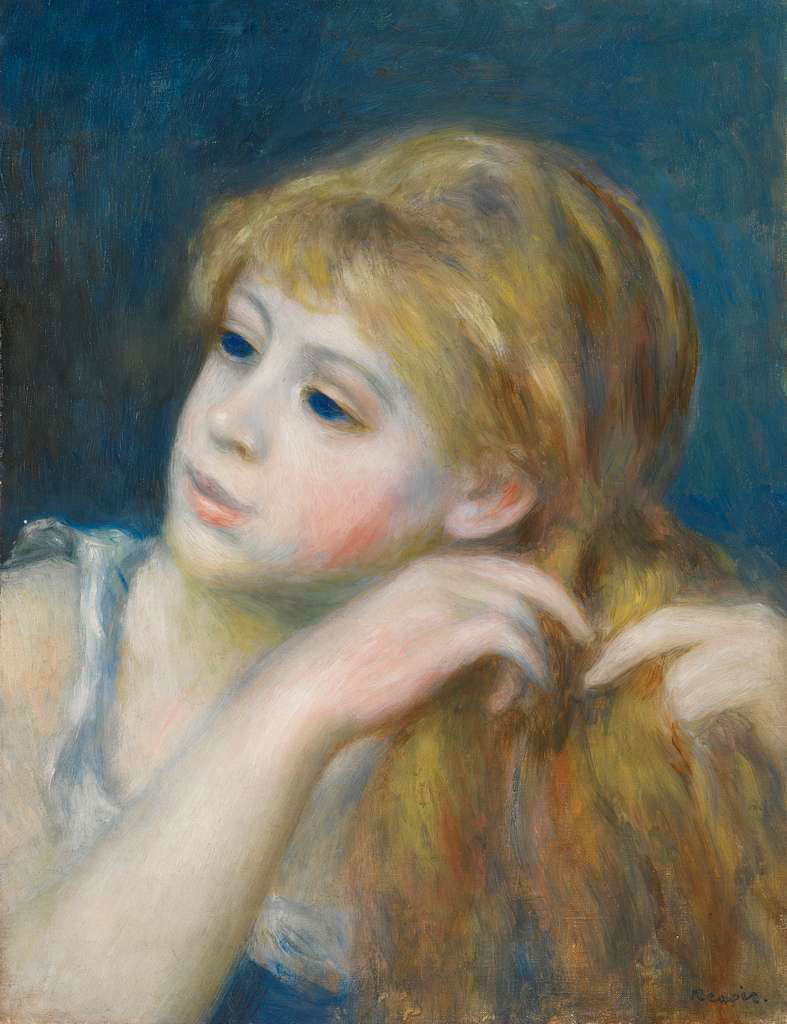
All of these qualities translate to a medium that can go anywhere and do anything. The only thing required of you is engagement. Pastel tells you just what to do to find inspiration if you listen:
“I am solid and permanent, so hold me with care. The lines I leave will stay, so if you want the page to shine through, shade lightly from the side. If you desire saturation, stick to the point and hold firm.
I shine with my own light, countless mirrors on a micro-scale; let me glow! Let my background suit your mood. I can stand up to it.
Because I am dry, I can be used fluidly; time is not my enemy. Play, dance, add, smudge, and dash. I embrace the moment, so you can too!”
Or something like that. The point is pastel is good-natured, sweet even, and its voice can speak to virtually any taste or mood. Use it alone, mix and match with other media, try quick sketches that let the page peek through, or deeply saturated works where the only light there is bursts from the colors themselves. Let loose, and get messy; pastel is the kind of pal that invites you to play, so accept the invitation and have fun!
Pastel has been with many of us since childhood. Yet, it offers us the kind of relationship that can continue growing alongside us. Artists from the Renaissance to the present have been wowing us with just how versatile this medium can be, reminding us that the only limits to what we can create are those we set.
We can trust pastel because it can go anywhere with us, do anything we ask, and won’t fade away. Being true to its word is much of what gives it its dulcet tones. In a world as chaotic as ours can sometimes be, it feels good to be able to rely on something. Few things are sweeter than that.
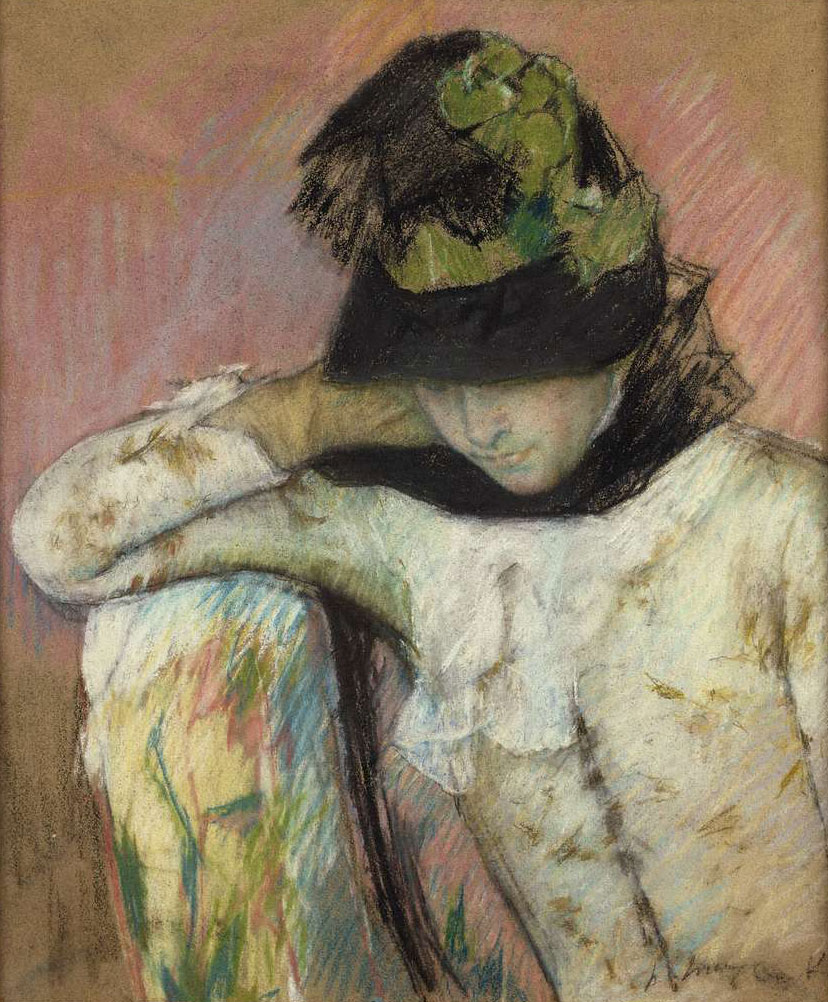
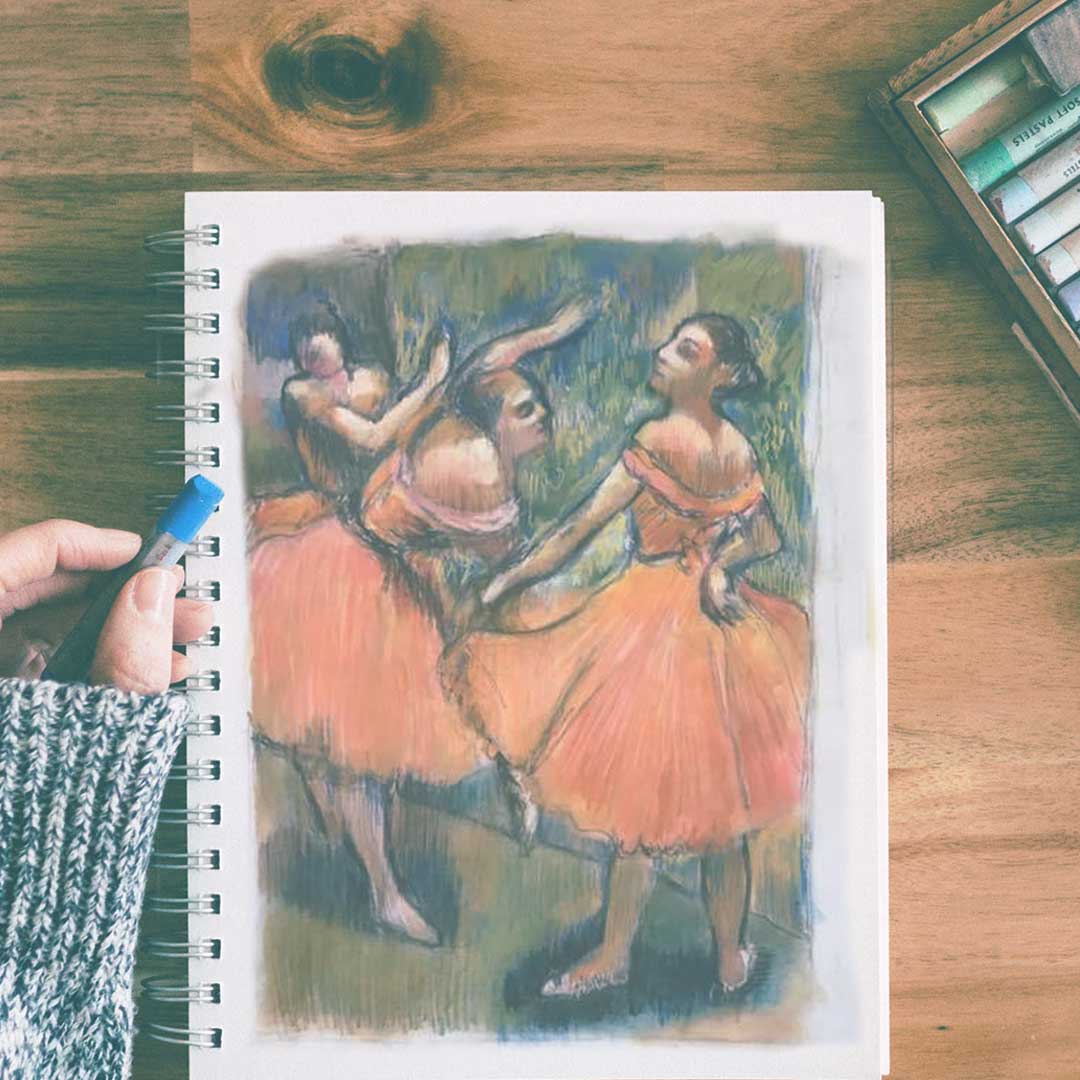
In relation to artists working with soft pastels, spontaneity plays a significant role in the creative process. Soft pastels allow artists to work quickly and directly, encouraging immediate and instinctive responses to the subject matter. The softness and blendability of pastels make them conducive to spontaneous mark-making and fluid expression.
Artists working with soft pastels can embrace the spontaneous nature of the medium by allowing themselves to respond intuitively to their subject, exploring bold and energetic strokes, and capturing the essence of a scene or emotion without overthinking or excessive planning. This uninhibited approach often leads to fresh and authentic artistic expressions, as the artist's instincts and emotions come through more naturally.
The immediacy of soft pastels allows for a direct and tactile connection between the artist and the medium, facilitating the exploration of spontaneity in the creative process. It encourages artists to trust their intuition, take risks, and let go of rigid control, ultimately leading to dynamic and expressive artworks that possess a sense of vitality and life.
Get those journals and sketchbooks out and get ready to do some self-reflection and writing. Try not to judge what comes out of these writing sessions. Don’t worry about punctuation or grammar or any of that. You can even just make lists if that suits you better. Remember, journaling is a deeply personal practice, so feel free to adapt these prompts to better suit your own thoughts and experiences.
Take a moment to get quiet. Still yourself by doing some gentle breath work. Light a candle. Now ask yourself some questions to reflect upon -
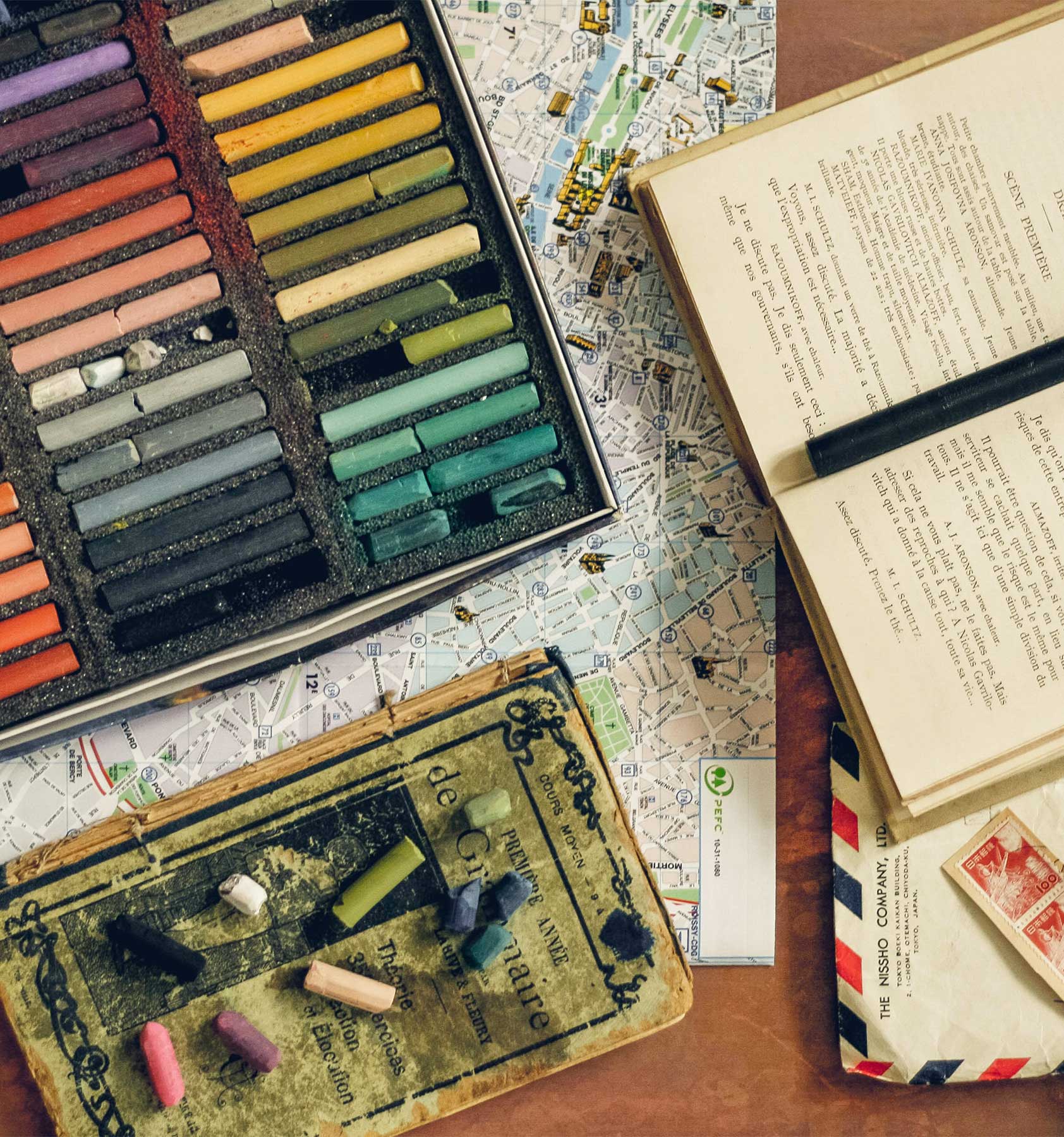
I am sharing this beautiful energy experience session from one of my favorite meditation masters - Rachel Hillary. This journey will help you to feel more grounded and connect with your inner peace. Give yourself some quiet time to enjoy this beautiful meditation.
Rachel will share a little about this experience -
This is a gentle guided meditation with a few minutes of simply music and voice (heart singing tones) which is all designed to enable you to find the sanctuary within. In this time there is so much noise, guidance and advice everywhere, this piece is created to root you back into source, back into your heart, to expand your heart energies and frequencies and listen to your own truth and knowing. Come back to yourself, come back to your heart. Music by indiemusicbox.com and the singing is my own.
lots of love,
Rachel
Each month we will have a positive affirmation. I recommend you print out this affirmation and put it in your sketchbook or somewhere in your studio. Recite the affirmation out loud each time you show up to create. Saying words aloud is powerful and can begin to re-write some of our own limiting beliefs or calm our fears. Try it now…
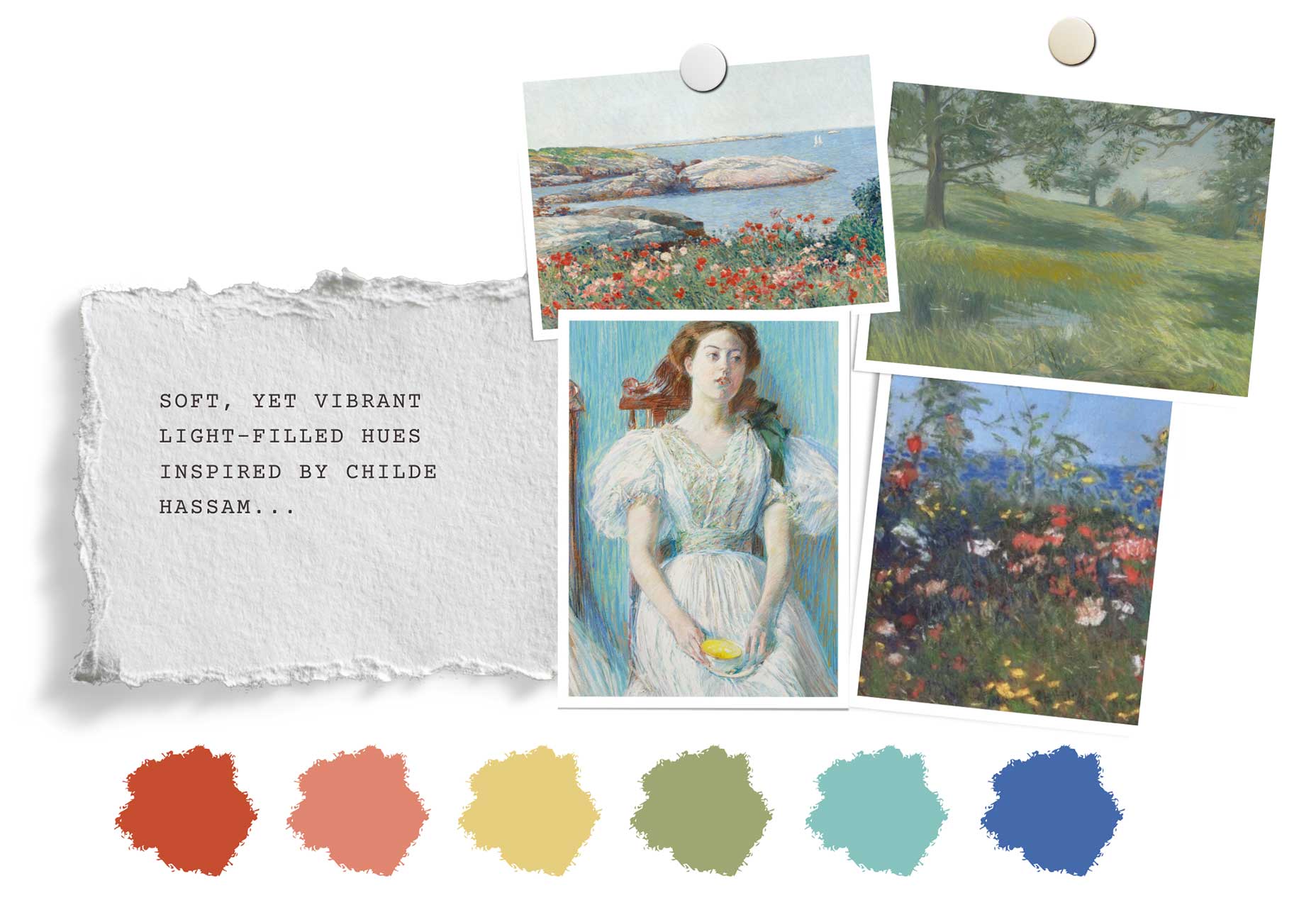
This month we are inspired by our master artist, Childe Hassam. Known for his vibrant and atmospheric artworks, employed a wide range of colors in his pastel compositions. His use of color was integral to capturing the essence of light, atmosphere, and the unique mood of each scene he depicted.
Hassam's pastel works often feature a rich and varied palette, with colors that are both harmonious and bold. He embraced the luminosity and transparency of pastels to create works that shimmer with vitality and capture the fleeting effects of light and shadow.
In his landscapes, Hassam depicted the changing seasons with a keen eye for color. He used delicate pastel shades of blues and purples to convey the tranquility of twilight or the crispness of a winter's day. Vibrant greens, yellows, and oranges captured the lushness of spring and the warm glow of autumn. His landscapes were often enlivened by touches of vibrant reds, pinks, and blues, adding focal points of interest within the compositions.
When depicting urban scenes, particularly bustling city streets, Hassam utilized a more varied and dynamic color palette. He incorporated a multitude of hues to convey the energy and vibrancy of city life. Warm ochres, burnt siennas, and deep browns represented the brick facades and architectural details, while pops of bright reds, blues, and yellows captured the movement and vitality of people and vehicles in the cityscape.
Hassam's command of color extended to his depictions of interiors and still lifes as well. In these works, he employed a range of warm and cool tones to create depth and convey the play of light and shadow. Soft pastel pinks, blues, and lavenders lent an air of tranquility and elegance to his indoor scenes, while his still lifes showcased a harmonious blend of complementary colors.
Overall, Childe Hassam's pastel artworks display a mastery of color and a sensitivity to the nuances of light and atmosphere. Through his use of an extensive and diverse palette, he created works that resonate with a captivating luminosity, inviting viewers to immerse themselves in the vibrant world he captured on paper.
Welcome to this master artist study, where we will delve into the captivating world of Childe Hassam and his remarkable pastel works. In this exploration, we will uncover the lesser-known side of this influential American Impressionist painter, renowned primarily for his iconic oil paintings.
In his pastel works, he showcased his ability to capture light, color, and atmosphere with remarkable skill. He embraced the softness and versatility of pastels to create delicate and nuanced renderings of landscapes, cityscapes, and intimate scenes.
Let’s learn more about this incredible artist…
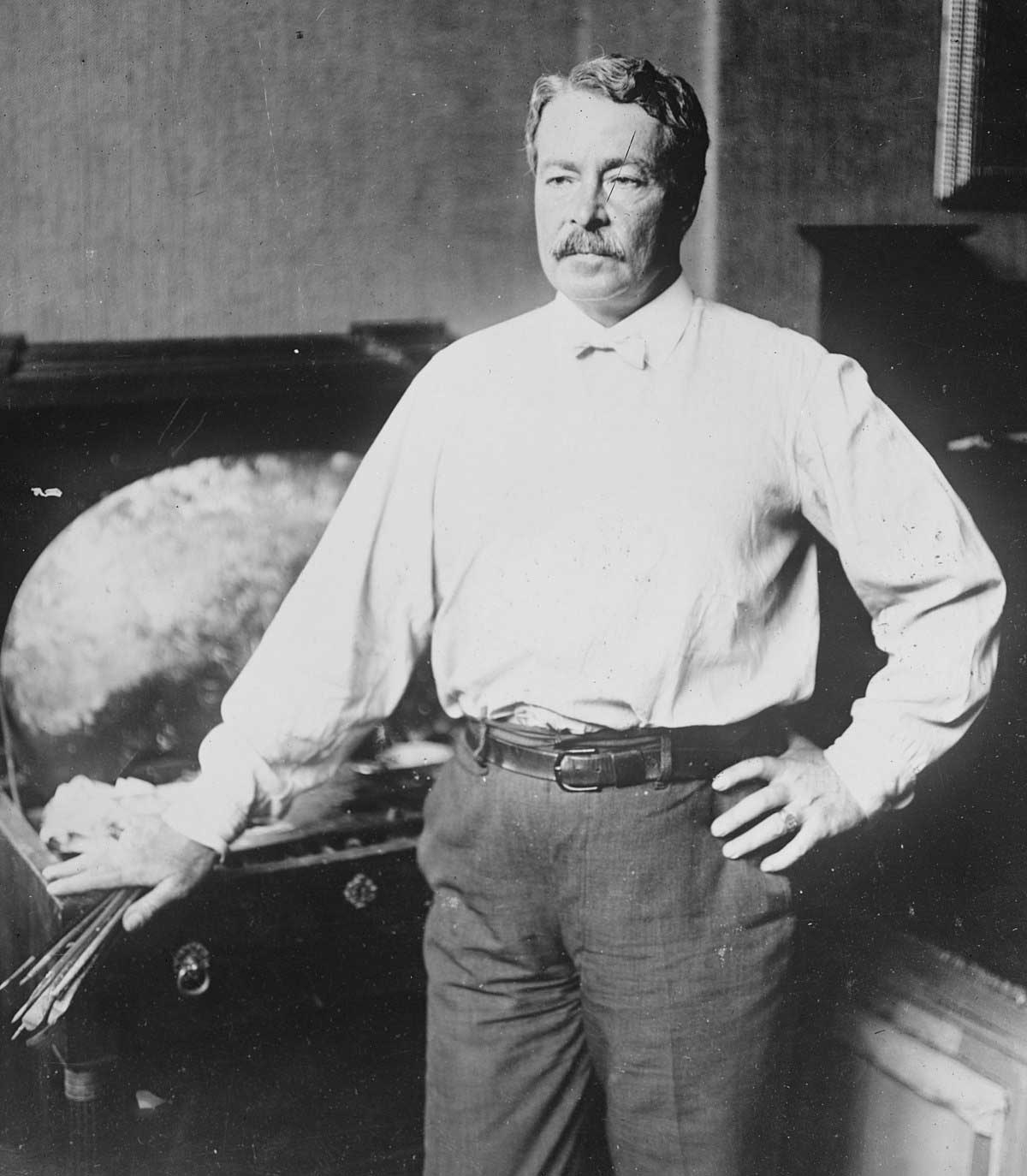
Frederick Childe Hassam, commonly known as Childe Hassam, was an influential American Impressionist painter known for his vibrant and atmospheric artworks. While he primarily gained recognition for his oil paintings, Hassam also made significant contributions to pastel art.
Hassam was born on October 17, 1859, in Dorchester, Massachusetts. He developed an early interest in art and received his formal training at the Boston Art Club and the Académie Julian in Paris. He was heavily influenced by French Impressionism, which greatly shaped his artistic style.
Hassam was a prolific and versatile artist, working in various mediums including oil, watercolor, and pastel. In his pastel works, he showcased his ability to capture light, color, and atmosphere with remarkable skill. He embraced the softness and versatility of pastels to create delicate and nuanced renderings of landscapes, cityscapes, and intimate scenes.
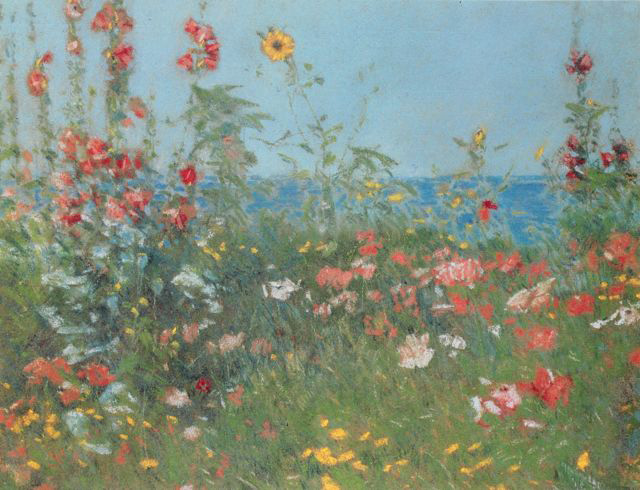
Poppies Isles of Shoals
Frederick Childe Hassam - 1891
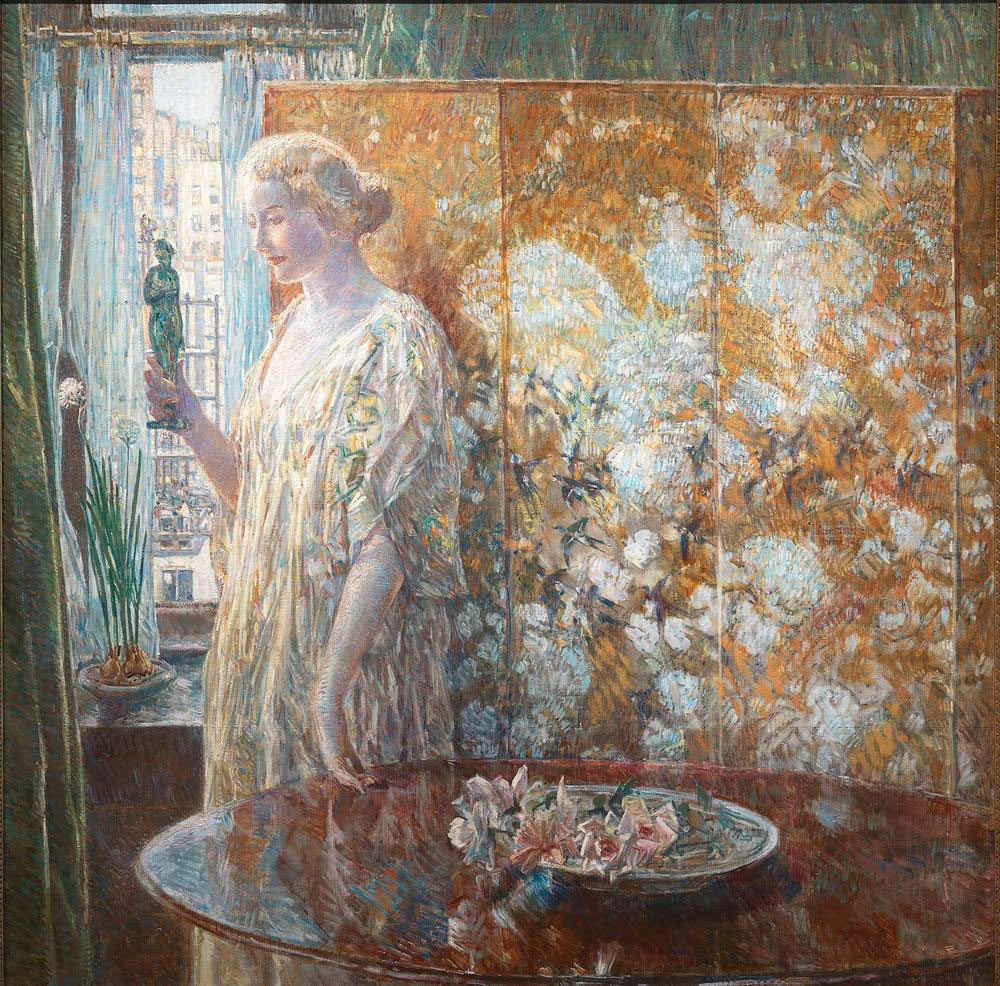
Tanagra (The Builders, New York)
Frederick Childe Hassam - 1918, oil on canvas
While his oil paintings gained more widespread recognition during his lifetime, Hassam's pastel works were highly regarded by fellow artists and critics. He participated in numerous exhibitions, including the influential Armory Show in 1913, which introduced American audiences to modern art.
Childe Hassam's legacy as an American Impressionist artist continues to inspire and influence artists today. His pastel works serve as testaments to his mastery of capturing light, his keen eye for composition, and his ability to convey the vibrancy of his subjects.
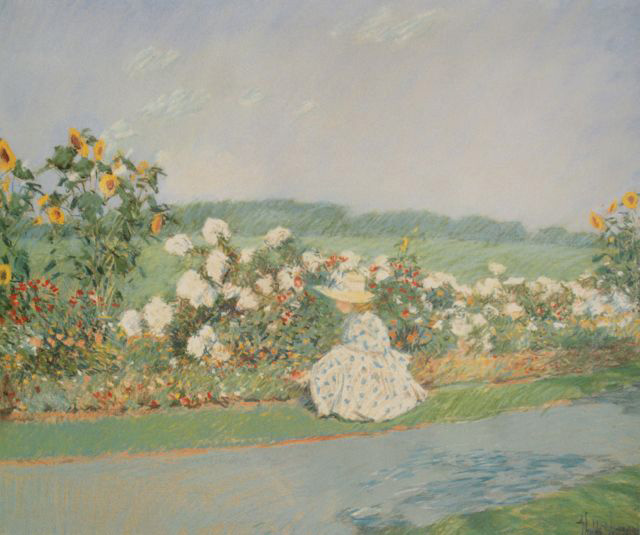
Summertime
Frederick Childe Hassam - 1891, pastel-on-paper
Mastery of color: Hassam skillfully employed a wide range of colors, capturing the nuances of light, atmosphere, and the changing seasons in his compositions.
Bold and confident strokes: His pastel works exhibited confident and deliberate strokes, showcasing his command over the medium and creating a sense of energy and movement.
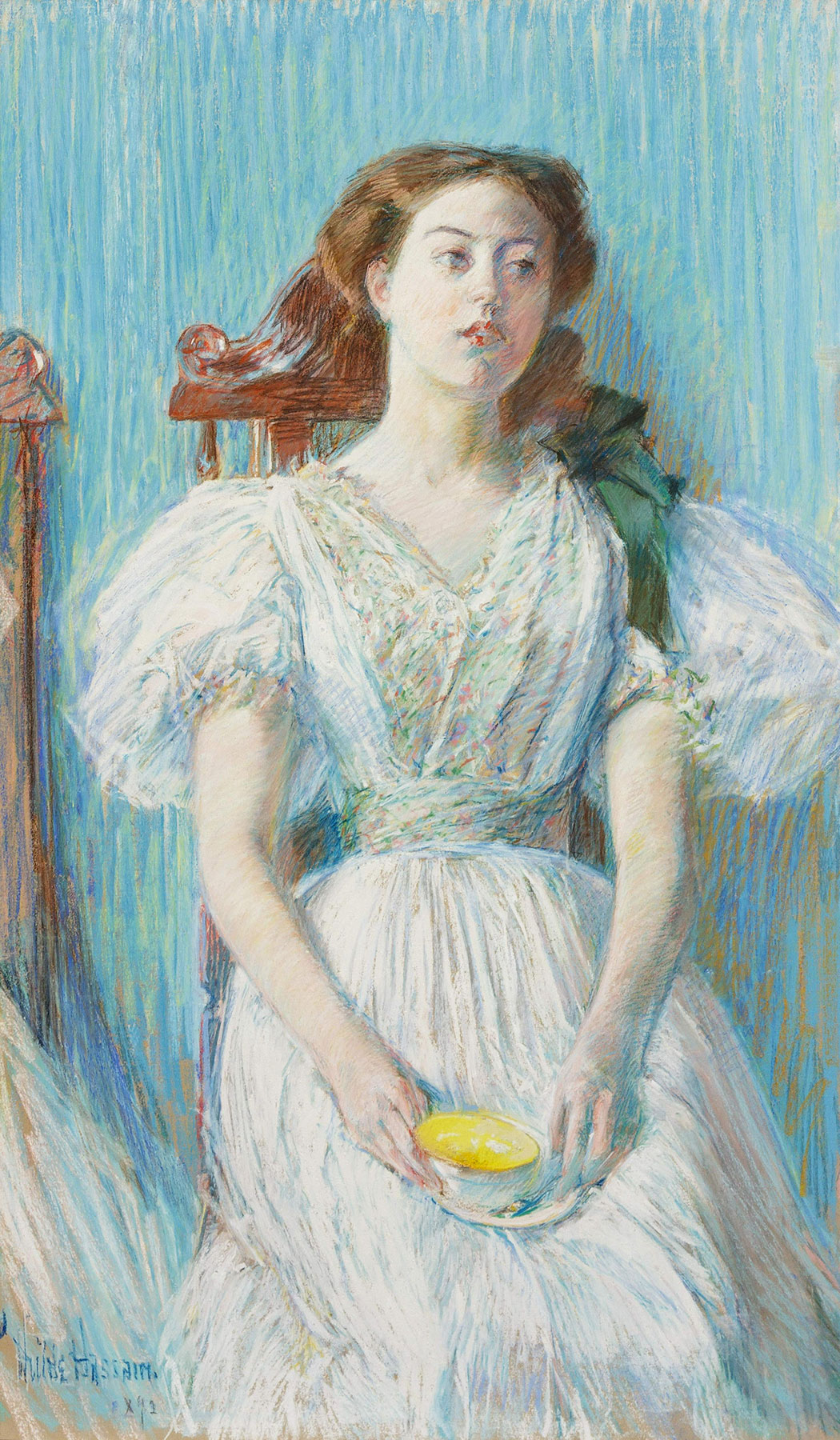
Portrait of Ethel Moore
Impressionistic approach: Hassam embraced the principles of Impressionism, employing loose markmaking and a focus on capturing fleeting moments and atmospheric effects.
Delicate handling of light and shadow: He adeptly depicted the interplay of light and shadow, utilizing subtle variations in pastel hues to convey depth, luminosity, and the effects of natural light.
Capturing the essence of urban scenes: Hassam's pastel works often depicted bustling city streets, where he captured the energy and vitality of city life, using dynamic compositions and a vibrant color palette.
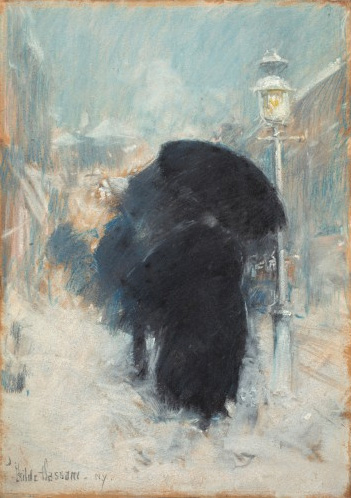
A New York Blizzard
Harmonious and balanced compositions: His pastel artworks demonstrated a strong sense of composition, balancing elements and creating visual harmony within the frame.
Attention to atmospheric perspective: Hassam employed techniques such as the softening of edges and the use of lighter and cooler tones in the background to convey depth and atmospheric perspective.
Sensitivity to the effects of season and weather: His pastel works showcased a keen observation of seasonal changes, with a focus on capturing the distinct colors and moods associated with different times of the year.
Skillful rendering of natural and architectural details: Hassam's pastel technique allowed him to depict intricate details of landscapes, foliage, and architectural elements with precision and finesse.
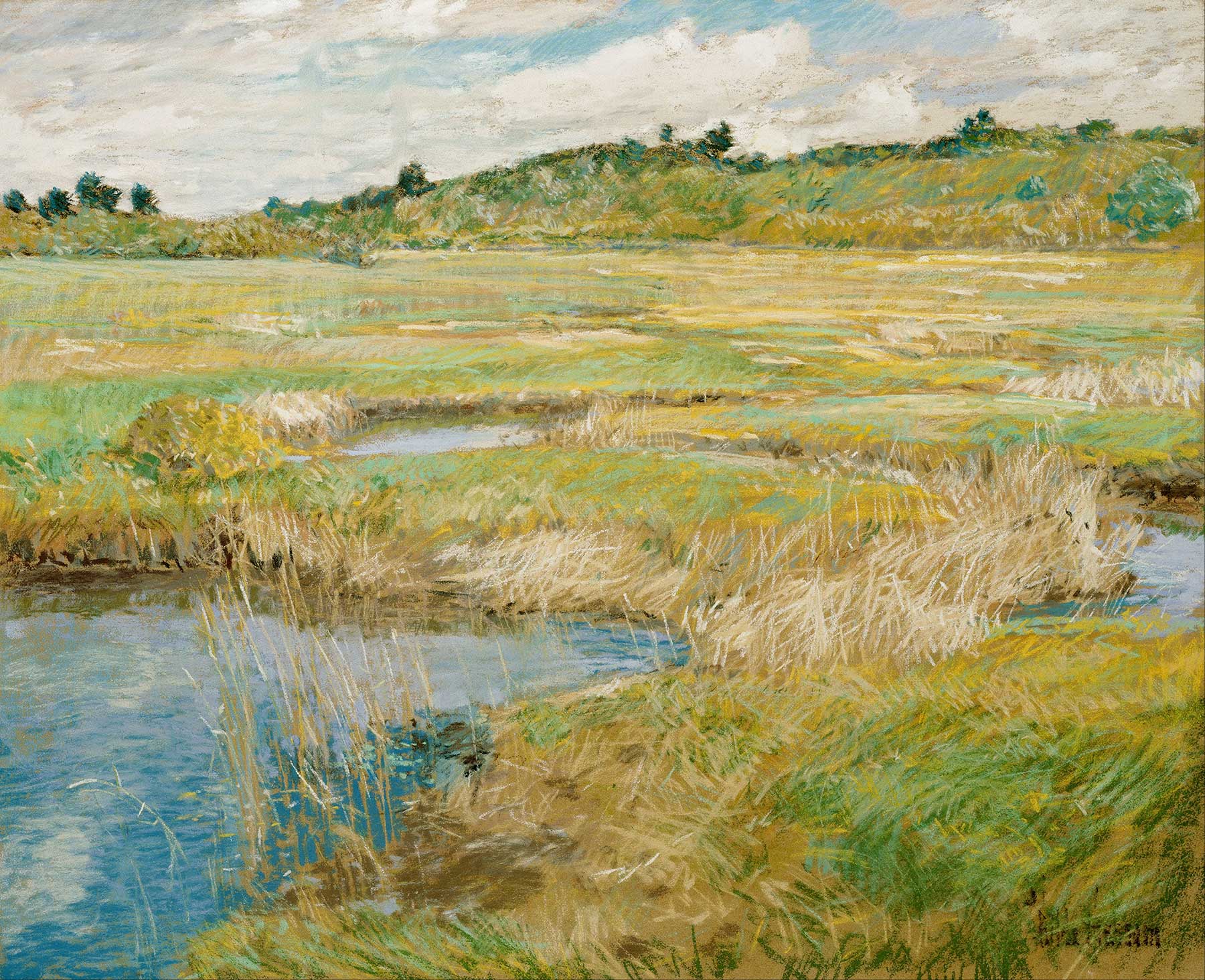
The Concord Meadow
Expressive use of pastel medium: He leveraged the unique qualities of pastels, including their softness, blendability, and vibrant pigments, to create artworks that shimmered with luminosity and evoked a sense of painterly spontaneity.
These techniques and approaches contributed to Childe Hassam's distinct artistic style and his ability to capture the essence of light, atmosphere, and the fleeting beauty of his subjects in his pastel works.
Enjoy a beautiful slideshow of Childe Hassam’s work that includes both his oil and his pastel paintings so you can witness the connection.
Here are a few of the most commonly used techniques when creating in soft pastel! I encourage you to give these a try this month…
After you and Dawn (Vanderstoep) have been introducing PanPastels,I am in love with them. I love their smoothness and their blending AND it isn‘t such a mess like with other substrates. Thanks for your lessons. - Renate B.
I love soft pastels! I love how they feel in my fingers ! You can work expressively and bold, or subtle and refined with soft pastel. You can create bold colors or very subtle ones. You can create a simple drawing with one colour or your can create a complex layered painting. Pastels offers so few limitations! - Daniela A.
I absolutely love working with soft pastels! They give me freedom to play without mixing colors or worrying about much cleanup. - Caroline M.
Pastels are dreamy! The colors are so rich and vibrant but also can be soft and subtle. I love the variety this bring to my work! - Anne M.
Pastels bring out the kid in me! I love looking at all the colors and smudging and blending them on my paper. Now, I just have to stop buying them! Lol. - Karen B.
I love pastels. I love how I can be delicate and soft, ethereal even. They give some of my work a dream like quality I just can't get with any other medium. It's pure magic.
- Ashley S.
Select a limited range of pastel colors and create a series of small color studies. Experiment with layering, blending, and contrasting these colors to explore their interactions and the emotions they evoke. Observe how different combinations and arrangements can create unique visual effects.
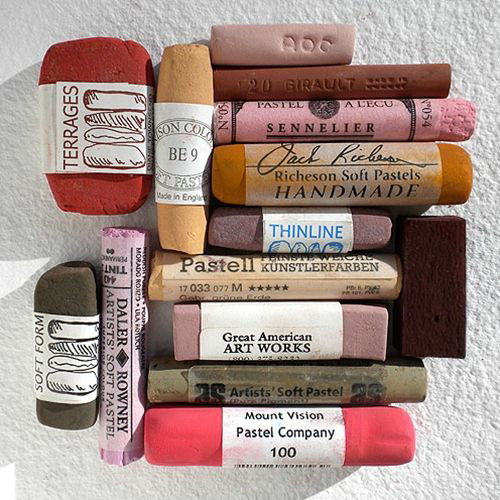

Create a series of quick pastel portrait sketches, focusing on capturing the essence and mood of your subjects. Experiment with different mark-making techniques to convey emotions and individual characteristics. Use pastels to explore the versatility of the medium in depicting human expressions and personalities.
Take a good look at Hassam’s pastel paintings and create a master study. This is an excellent opportunity to expand your knowledge and step into the shoes of another artist. Remember the goal is to learn from the process and not overly stress about creating a perfect reproduction. Have fun with it! Check out our Pinterest board for inspiration.

We're excited to take you on a journey to explore the unlimited possibilities of creating with pastels.
Inside this beautiful lesson by Dawn Vander Stoep, We'll take an intimate look at the creative process she's developed over the past five years of using this incredible medium.
Dawn has always felt drawn to the bumblebee and was inspired to express their energy connection with nature and the world around us. We hope you will enjoy creating one for yourself.

One of my favorite things to do is to curate inspiration. From Pinterest boards to books, resources, playlists and more - I love to share anything that might facilitate learning, expansion, and sparks of curiosity! Being an artist, we naturally crave these things so here are some of this month’s picks from me to you.
I had so much fun curating this list. I hope you enjoy!!
Here are just a few of our fantastic classes! I highly recommend checking them out if you haven’t already. Enjoy!